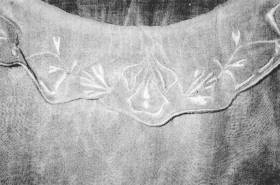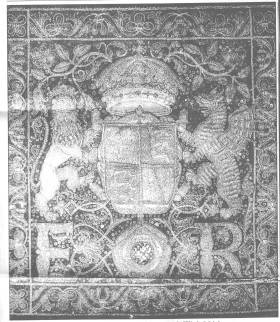| Newsletter
- of the CIETA Embroidery Group Bulletin d’Information de Groupe Broderie de CIETA No 5 |
 |
| Dear members, | St Gallen, 20 May 1997 |
ANNE WANNER'S Textiles in History / CIETA Embroidery Newsletters
|
| Thank you again for your
interest and your contributions. In this letter you will find the description
of some interesting exhibitions, for example the
exhibition in the Jewish Museum in Amsterdam and the
informative introduction of Pat Griffiths. Pat also
corrected my summaries, I want to thank her very much for
these contributions. I am also grateful to Rosalia Bonito
Fanelli, she sent her lecture of 20th century
embroideries. Anne
Wanner-JeanRichard |
General
information: |
| General information: Conference in Cambridge, September
1997 subject: church embroideries of the 17th and 18th centuries a special room will be reserved, there is no slide projector please bring with you Three Ladies, all of them
members of CIETA, ask to get the Embroidery News Letter: |
Embroidery
lecture in Milano, Italy |
| Rosalia Bonito
Fanelli Fortune Del Ricamo: from a serie of Lectures Centro Italiano Per Lo Studio Della Storia Del Tessuto lecture: Renewal in Embroidery at the turn of the century 27 November 1996 During the period covering from the late
nineteenth century up until the 1930s three tendencies in
embroidery can be noted: 1) hand embroidery based on
designs from antique model books and from traditional
folk patterns, 2) mechanical embroidery strongly promoted
because of the needs of contemporary female fashions,
3)embroidery as a pictorial and artistic medium. |
"Aemilia Ars" style-Renaissance motif |
| This historical revival arose first of all in England due to the cultural ideas of the Preraphaelites and then was fully developed through the efforts of William Morris and Edward Burne-Jones, and of Morris’s daughter, May, who was a teacher at the Royal School of Embroidery in South Kensington. But the historic revival in embroidery in Italy, rather, came about through the humanitarian and historic and artistic orientations of the "Industrie Femminili Italiene" (The Italian Feminine Industries), an organization of female cooperatives grouped together in 1903. Notable in these regional associations was the Bolognese cooperative, "Aemilia Ars". According to statistics in 1908 the organization comprised 32 regional committees and 473 associated enterprises which included laboratories and schools. These cooperative groups not only marked the rise in importance of women and their business capacities but also gave poor urban and country women a means to earn their own money. For some time in Protestant Europe and in the United States attempts had already been made to alleviate the feminine condition through embroidery and handicrafts. And it is not by chance that this philanthropic and humanitarian idea behind the Industrie Femminili Italiane was underwritten and sustained by illuminated Italian noblewomen and foreign women resident in Italy: for example, the countesses Cavazza, Adriana Marcello, Maria Pasolini, Antonia Suardi, or the foreignborn Cora Slocomb Brazzà, Esther Lyle Smith, Edith Bronson Rucellai and many others. |
| The second tendency of embroidery at this time owed it resurgence to the nineteenth-century invention and successive innovations of mechanical embroidery machinery such as Schiffli, Raschel and Cornely. From Belle Epoque fashions with intricate decorations in soutache, cordonet and jets, and from the fluttering, muslin garden-party dresses à la Proust with delicate white-on-white embroidery of 1905-1912, there is a passage to the straight shifts or chemise of the 1920s Charleston era completely covered with beads, sequins and false jewels. There is a passage from an exquisitely laborious and time-consuming, manual embroidery technique for these decorations to a mechanical application, a faster and more functional technique, though not necessarily less effective or more economical. The third tendency considered embroidery as a technical medium like paints or pencils for the execution of art works, above all in the applique technique. Examples of this usage can be found from the English "Arts and Crafts" to Art Nouveau, Symbolism, Expressionism, Fauvism, |  Blouse - Art Nouveau motif |
| Futurism and Surrealism.
Here, too, there is a significant participation of women
not only executing the embroidery of art works designed
by men - oftentimes husbands, sons or brothers - but also
creating the very desings themselves. While in England is found a renewed interest in the embroidered tapestry - a tradition which began in the Middle Ages with the Bayeux tapestry, in France occurs new artistic experimentation with applique and other embroidery stitches. Artists of the Symbolist movement such as Maurice Denis, Paul Ranson and Emile Bernard contributed important works. In Italy the Futurist artists worked largely
in the applique technique. In particular Fortunato Depero
and Giacomo Balla utilized applique for wallhangings and
clothing to create special "dynamic" effects
throuth combinations and juxtapositions of cloth-segments
of various forms and colors. |
New
acquisition by the British Museum 1997 |
| Embroidered
Elizabethan Burse which once held the Great Seal of England (Note in: The Guardian, Thursday March 13, 1997) contribution of Santina Levey |
 |
| story is supported by the
presence of two strips of velvet embroidered with wheat
ears that are still attached to the sides of the burse.
The history of the panel is being checked by the staff of
the British Museum but they confident that the link with
Thomas Egerton will be proved correct. The burse is a wonderful example of English professional embroidery; on a panel of crimson velvet, with blue and crimson satin applied behind the Coat of Arms, gold and silver wire, thread, purl, strip and spangels have been skilfully worked over a padding to create a variety of patterns and textural effects. It is almost certainly the work of the Queen’s embroiderer, John Parr, who was appointed in 1581 and died in 1607. Sent by Pat Grifiths The purse, in crimson velvet worked with gold and silver threads, has the lion and Welsh dragon flanking the royal arms, the initials ER, and a Tudor rose. It was to have been auctioned by Sotheby’s after being valued at more then £ 30’000. It would almost certainly have gone overseas. The British Museum has acquired it with a £ 28’200 lottery grant and a further £ 10’000 from the independent art charity, the National Art Collections Fund. The museum already holds the national collectrion of seal dies, and drawings from Elizabethan great seals. The embroidery was found in an attic in London. The discovery in a trunk caused surprise as the family knew nothing of its history. An auction label on the frame gave the lot number 667, and said it came from Plas Llangoed in Anglesey. It set Sotheby’s on the trail of 400 years of history of the purse, and the Jones family whose Welsh estate was scattered by auction in 1890. Edward Jones, founder of the estate, was on the staff of Sir Thomas Egerton, the last of Elizabeth’s Lord Keepers of the Seal, and was presumably given the purse as a favour. It is recorded in his widow’s will of 1632 as "a cushion of velvet embrodered with gould which was a seale purse". |
Masterworks in the
Schnuetgen Museum, Cologne |
| Title: Textile
Kunst aus Tausend Jahren, Meisterwerke im
Schnuetgen-Museum, Koeln author: Gudrun Sporbeck, Photographs by Thomas Zwillinger year: 1996, text in German, pages: 79, illustrations: 35 most in colour, Koeln ISBN 3-7743-0299-5 |
Exhibition in Benedictine
Abbey of Admont, Auistria |
| Title: Faszination
in Seide, Gold und Silber Benediktinerstift Admont, barocke Sakralstickereien im kunsthistorischen Museum author: Dr Christl Eger year: 1996, pages: 23, Illustrations: 15 black and white, 4 in colour, ISBN: no number text in German |
Exhibition and book,
Fitzwilliam Museum, Cambridge |
| Title of the
exhibition: Samplers 29 April - 31 August 1997 Octagon, Fitzwilliam Museum, Trumpington Street, Cambridge Opening times: Tuesday-Saturday 10.00-17.00, Sunday 14.15-17.00, Closed Mondays, admission free Title of the book: Samplers Further information from: |
Exhibition and 2
catalogues, Amsterdam |
| Title of
exhibition: Joods van Stof. Verhalend textiel uit
eigen collectie 18 April - 19 October 1997 Jewish Historical Museum, Jonas Daniël Meijerplein 2-4, Amsterdam Title
of the catalogue: Orphan Objects. Facets of the
Textiles Collection |
Exhibition, Rijksmuseum,
Amsterdam Book:
Embroidery in India |
| Title of the
exhibition: Distance lends enchantment. Exotic
textiles in the Netherlands 28 March - 14 September 1997 The exhibition is accompanied by a leaflet of the same title (obtainable in Dutch or English) with nine colour illustrations. The subject is also covered in an article: |
| Title: Nur Jahan’s
Embroidery
Trade and Flowers of the Taj Mahal, in: Asian Art & Culture, Vol. 9, No 2, pp. 7-23 author: Ellison Banks Findly year: 1996 |
Exhibition
in the Textile Museum, St Gallen |
| Title of the
exhibition: Coloured embroideries from Zagreb to
Istanbul 18 March 1997 - end of February 1998 Textilmuseum, Vadianstrasse 2, CH- 9000 St.Gallen Opening times: Monday-Saturday 10.00-12.00 and 14.00-17.00, Closed Sundays Press release: |
| in the public baths, as covers; they provided covers for books, furniture, and mirrors. It is not easy to make clear distinctions between embroideries from other Balkan countries. Apart from features peculiar to individual regions, the delight in colours characteristic of the western Latin part is expressed in many places; elsewhere, Islamic and Orthodox influences are also evident.The stylistic development and the absorption of a variety of elements is undoubtedly connected with the historical past of the Balkans. This is where Orient and Occident with their differing views and religions meet, both impetuously and painfully. As a consequence, simmering unrest and military conflicts have remained to this day. |
|
Book review: embroidery and
collection in Stuttgart |
| Title:
Stickerei, von der Vorzeit bis zur Gegenwart author: Ruth Groenwoldt year: 1995, text in German, pages: 288, illustrations: 460 alltogether, 260 in colour, Hirmer, Muenchen, 1993 ISBN 3-7774-5840-6 |
| home newsletters | Last revised August 12, 2000 |